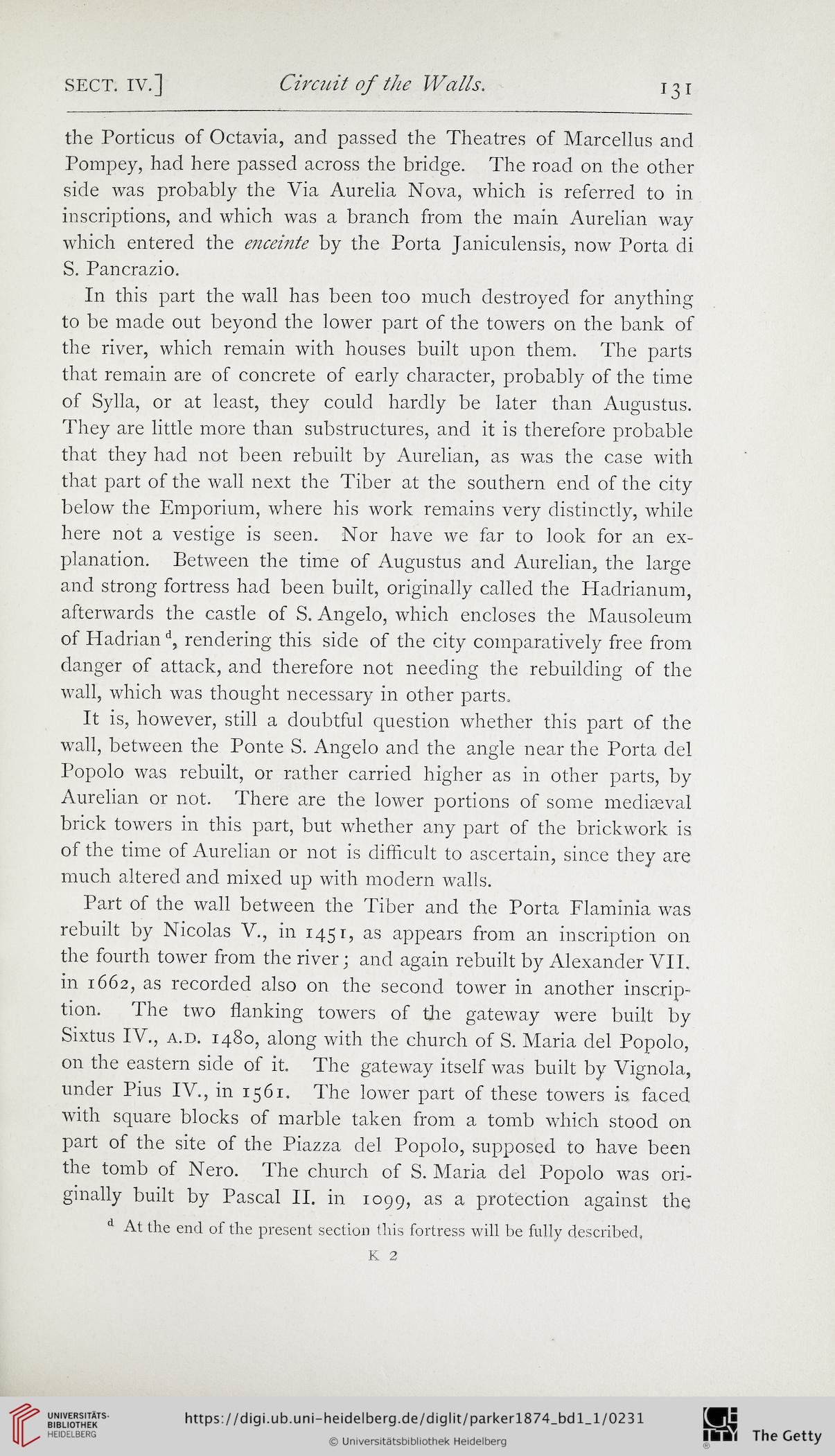SECT. IV.]
Circuit of the IValls.
the Porticus of Octavia, and passed the Theatres of Marcellus and
Pompey, had here passed across the bridge. The road on the other
side was probably the Via Aurelia Nova, which is referred to in
inscriptions, and which was a branch from the main Aurelian way
which entered the enceinte by the Porta Janiculensis, now Porta di
S. Pancrazio.
In this part the wall has been too much destroyed for anything
to be made out beyond the lower part of the towers on the bank of
the river, which remain with houses built upon them. The parts
that remain are of concrete of early character, probably of the time
of Sylla, or at least, they could hardly be later than Augustus.
They are little more than substructures, and it is therefore probable
that they had not been rebuilt by Aurelian, as was the case with
that part of the wall next the Tiber at the southern end of the city
below the Emporium, where his work remains very distinctly, while
here not a vestige is seen. Nor have we far to look for an ex-
planation. Between the time of Augustus and Aurelian, the large
and strong fortress had been built, originally called the Hadrianum,
afterwards the castle of S. Angelo, which encloses the Mausoleum
of Hadriand, rendering this side of the city comparatively free from
danger of attack, and therefore not needing the rebuilding of the
wall, which was thought necessary in other parts.
It is, however, still a doubtful question whether this part of the
wall, between the Ponte S. Angelo and the angle near the Porta del
Popolo was rebuilt, or rather carried higher as in other parts, by
Aurelian or not. There are the lower portions of some mediaeval
brick towers in this part, but whether any part of the brickwork is
of the time of Aurelian or not is difficult to ascertain, since they are
much altered and mixed up with modern walls.
Part of the wall between the Tiber and the Porta Flaminia was
rebuilt by Nicolas V., in 1451, as appears from an inscription on
the fourth tower from the river; and again rebuilt by Alexander VII.
in 1662, as recorded also on the second tower in another inscrip-
tion. The two flanking towers of the gateway were built by
Sixtus IV., a.d. 1480, along with the church of S. Maria del Popolo,
on the eastern side of it. The gateway itself was built by Vignola,
under Pius IV., in 1561. The lower part of these towers is faced
with square blocks of marble taken from a tomb which stood on
part of the site of the Piazza del Popolo, supposed to have been
the tomb of Nero. The church of S. Maria del Popolo was ori-
ginally built by Pascal II. in 1099, as a protection against the
d At the end of the present section this fortress will be fully described,
K 2
Circuit of the IValls.
the Porticus of Octavia, and passed the Theatres of Marcellus and
Pompey, had here passed across the bridge. The road on the other
side was probably the Via Aurelia Nova, which is referred to in
inscriptions, and which was a branch from the main Aurelian way
which entered the enceinte by the Porta Janiculensis, now Porta di
S. Pancrazio.
In this part the wall has been too much destroyed for anything
to be made out beyond the lower part of the towers on the bank of
the river, which remain with houses built upon them. The parts
that remain are of concrete of early character, probably of the time
of Sylla, or at least, they could hardly be later than Augustus.
They are little more than substructures, and it is therefore probable
that they had not been rebuilt by Aurelian, as was the case with
that part of the wall next the Tiber at the southern end of the city
below the Emporium, where his work remains very distinctly, while
here not a vestige is seen. Nor have we far to look for an ex-
planation. Between the time of Augustus and Aurelian, the large
and strong fortress had been built, originally called the Hadrianum,
afterwards the castle of S. Angelo, which encloses the Mausoleum
of Hadriand, rendering this side of the city comparatively free from
danger of attack, and therefore not needing the rebuilding of the
wall, which was thought necessary in other parts.
It is, however, still a doubtful question whether this part of the
wall, between the Ponte S. Angelo and the angle near the Porta del
Popolo was rebuilt, or rather carried higher as in other parts, by
Aurelian or not. There are the lower portions of some mediaeval
brick towers in this part, but whether any part of the brickwork is
of the time of Aurelian or not is difficult to ascertain, since they are
much altered and mixed up with modern walls.
Part of the wall between the Tiber and the Porta Flaminia was
rebuilt by Nicolas V., in 1451, as appears from an inscription on
the fourth tower from the river; and again rebuilt by Alexander VII.
in 1662, as recorded also on the second tower in another inscrip-
tion. The two flanking towers of the gateway were built by
Sixtus IV., a.d. 1480, along with the church of S. Maria del Popolo,
on the eastern side of it. The gateway itself was built by Vignola,
under Pius IV., in 1561. The lower part of these towers is faced
with square blocks of marble taken from a tomb which stood on
part of the site of the Piazza del Popolo, supposed to have been
the tomb of Nero. The church of S. Maria del Popolo was ori-
ginally built by Pascal II. in 1099, as a protection against the
d At the end of the present section this fortress will be fully described,
K 2




